Posts Tagged ‘Waterloo Region’
Posted on: December 17th, 2013 by Waterloo Region Crime Prevention Council
The crime rate records the amount of police reported crime per 100,000 people. In this number, all crimes are counted equally. This represents approximately one third of the crime that occurs in Canada; this varies by jurisdiction and type of crime. The Crime Severity Index and the Violent Crime Severity Index weight crimes according to their severity based upon average sentencing outcomes. Crime and violence severity indices address the crime rate being driven by high-volume offences that are of a less serious nature.
The Statistics
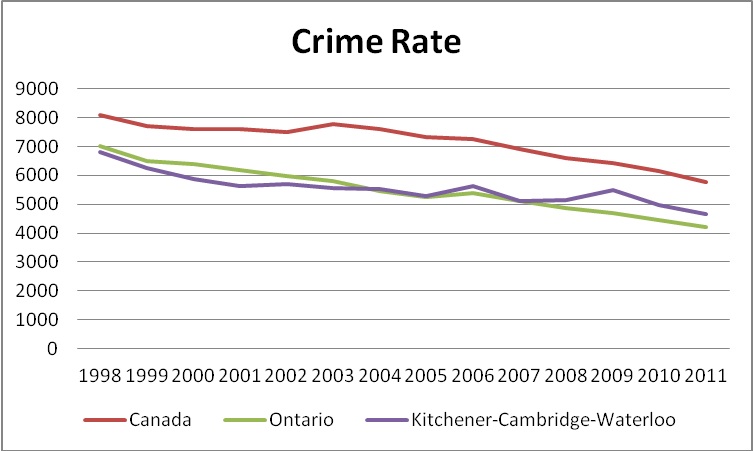

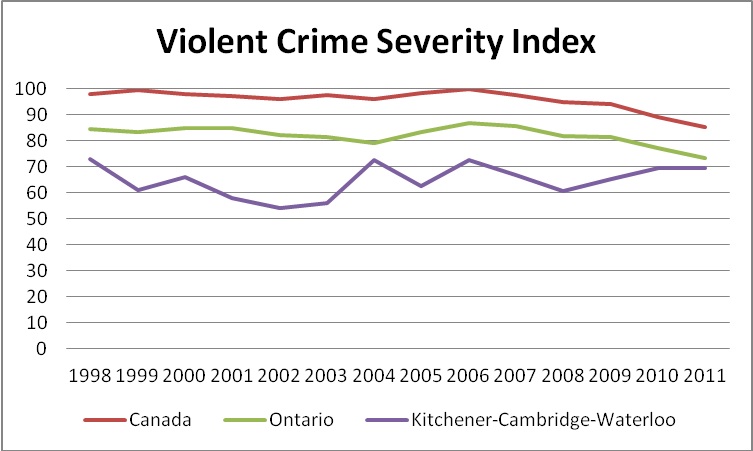 Date Sources: Statistics Canada, Uniform Crime Reporting Survey: CANSIM Table 2520051
Date Sources: Statistics Canada, Uniform Crime Reporting Survey: CANSIM Table 2520051
Statistics Canada, Uniform Crime Reporting Survey: CANSIM Table 2520052 (Released Annually)
The Story Behind the Numbers
Posted on: December 4th, 2013 by Waterloo Region Crime Prevention Council
Communities with a higher proportion of lone-parent headed households are associated with higher crime rates. Children from lone parent headed households face low incomes and other significant risk factors for becoming a victim or perpetrator of crime. The chart below tracks percentage of lone parent families in Waterloo Region and Ontario. The second chart tracks two parent family median incomes and single family median incomes. The gap between the two assesses whether single-parent headed households are falling behind when compared to two parent households.
The Statistics
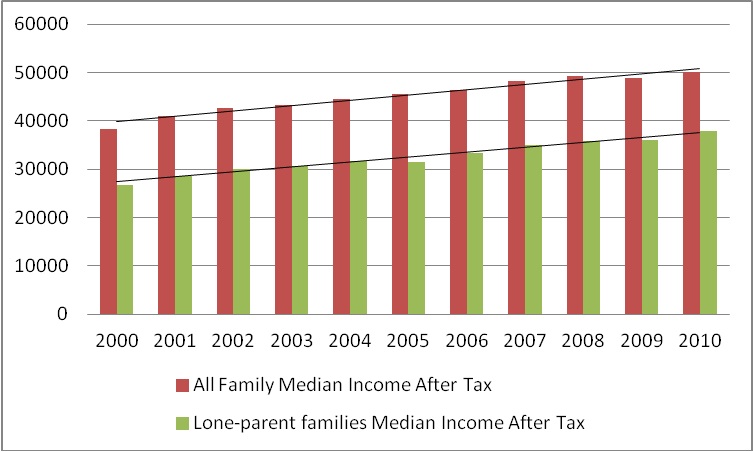
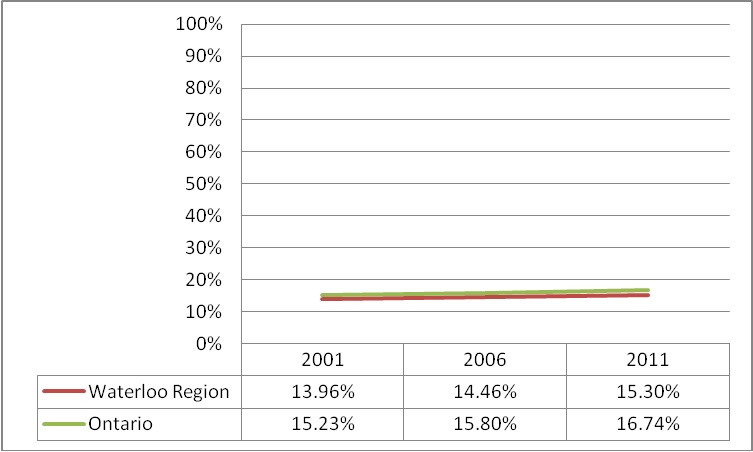 Data Sources: Statistics Canada, Census (Released Every Five Years); Statistics Canada, CANSIM Table 111-0015 (Released Annually)
Data Sources: Statistics Canada, Census (Released Every Five Years); Statistics Canada, CANSIM Table 111-0015 (Released Annually)
The Story Behind the Numbers
Waterloo Region has less single parent headed households than Ontario. However, single parent families have increased in Ontario and Waterloo Region over the past ten years. Interestingly in Waterloo Region the income of single parent headed households is growing slightly faster than two parent families in the Kitchener-Cambridge-Waterloo CMA. So while single parent headed households are growing in the region their income is keeping pace with average incomes, unfortunately they are not making any significant gains to close the gap.
Read the Community Response:
Single Parent Headed Households: A response from Big Brothers Big Sisters of Waterloo Region with Julie Philips
Posted on: December 4th, 2013 by Smart on Crime
To take a deeper look at the Single Parent Headed Households indicator in Snapshot in Time: Root Causes of Crime in Waterloo Region, we talked to Julie Philips, Chief Operating Officer for Big Brothers, Big Sisters of Waterloo Region.
1. What is your response to the data presented on this indicator/variable? How does it make you feel when you reflect on this indicator?
People often assume that children raised in a lone-parent family are more likely to live in poverty and are also more likely to commit crime. I would venture to say that children and youth from fragmented households are perhaps just as likely to commit crime as lone-parent offspring. What do I mean by fragmented? A two parent family, where the parents are too busy to invest time in their children. Parents who at the end of the day are too tired, burned out and stressed, leaving little time or energy to actively engage their children. Parents who create an unstable home life thus leaving their children to find their own sense of belonging, their network of support.
2. Who is involved in addressing this issue in your sector? What are you already doing about it?
Many organizations, both formal and informal are working to address this issue. Schools, teachers, faith communities, neighbourhood associations to social service agencies are working individually and as a collective to provide healthy networks of support for children and youth in our region regardless of family structure.
We believe in working with others to promote healthy and safe environments for children. Our programs are not “cookie-cutter or clinical” but are based on the power of friendship – having someone special to spend time with and count on. We have passion for excellence and our programs evolve with the emerging needs of our community through collaborative efforts and leveraging collective resources. Our programs are child-centered and therefore allow each child to be supported in a way that helps them reach their individual goals.
Children in our community based programs are primarily from lone-parent families or extended families.
One-to-One matches children and youth with the support of a caring adult mentor. The goal is that children and youth become empowered to reach their potential as engaged, confident and well-rounded individuals who are able to develop and maintain positive relationships.
Big Bunch provides children and youth with mentoring support through group programming. By participating in recreational opportunities, children and youth develop and maintain positive relationships, and become confident, engaged members of their community.
Children in our school based and summer programs are from a variety of family structures.
In-School Mentoring provides elementary students who could benefit from extra emotional, social or academic support, with a caring adult mentor. The goal is for students to become engaged, connected, contributing, skilled, and confident members of their school and community, empowering them to reach their potential.
Go Girls! Healthy Bodies Healthy Minds is designed for girls aged 12-14 and provides them with information to help make informed choices about healthy, active living and supports them in dealing with the emotional, social and cultural issues they may face. The goal of the program is that participants have a positive body image, high self-esteem, healthy eating habits, be physically active, and able to create and maintain healthy relationships.
Game On! uses a mentor approach to provide boys and young men with information and support to make informed choices about a range of healthy lifestyle practices. Through non-traditional physical activities, complemented with healthy eating support, participants are engaged in life skills, communication, and emotional health discussions designed to engage participants in the pursuit of life-long healthy lifestyles.
Summer Discovery supports children during the summer months. They enjoy all that summer has to offer games, crafts, activities and snacks! This day program is about having fun and building friendships, while learning and participating in physical activity together.
3. What else should be done and/or needs to be done about it?
There also needs to be greater engagement of children and youth in the process. Access to services and supports need to be simplified – it is currently too easy to get frustrated or lost in the system when trying to access support. A greater focus should be given to providing proactive rather than reactive strategies. We need to work towards removing the stigma sometimes felt by parents/families access services. The community as a whole needs to work collaborate to holistically address the needs of children and youth in the Region. This means valuing the working of the services providers and committing to sustainable revenue sources for service providers.
Thank you Julie! Thanks for your insights & responses.
 Author: Julie Phillips, a native of Cambridge, has an interest for world missions as well as local outreach. As the former Executive Director with Big Brothers Big Sisters of Cambridge she played a key role in the successful merger of the Cambridge and Kitchener-Waterloo chapters. With 12 years of experience in the non-profit sector and as Chief Operating Officer of Big Brothers Big Sisters of Waterloo Region she works towards providing youth in her community with the same opportunities she had when she was growing up. Julie is an active volunteer in her community and is passionate about the social issues affecting the well-being of our region’s residents.
Author: Julie Phillips, a native of Cambridge, has an interest for world missions as well as local outreach. As the former Executive Director with Big Brothers Big Sisters of Cambridge she played a key role in the successful merger of the Cambridge and Kitchener-Waterloo chapters. With 12 years of experience in the non-profit sector and as Chief Operating Officer of Big Brothers Big Sisters of Waterloo Region she works towards providing youth in her community with the same opportunities she had when she was growing up. Julie is an active volunteer in her community and is passionate about the social issues affecting the well-being of our region’s residents.
Posted on: November 25th, 2013 by Smart on Crime
“It is said that no one truly knows a nation until one has been inside its jails. A nation should not be judged by how it treats its highest citizens but how it treats its lowest ones” – Nelson Mandela
You have probably heard of Andrew Wiggins, Canada’s top high school basketball player. But do you know Ayodele Olutayo? Olutayo who? Is he a basket ball player or rapper? Google the name and you find nothing. So, what makes Olutayo special? Nothing really, except that he won a Rhodes Scholarship the very same week that Wiggins announced he was joining the University of Kansas men’s basketball team. Two stories. Two male black youth. Two very different media responses.
Unlike for Wiggins, the media was silent about Olutayo. Like they are about most good-news, positive stories. However, the media continues to obsess over stories that feed public appetite for fear and perpetuate western images of hyper muscular, hypersexual, anti intellectual and criminal black masculinity.
Let’s go back to Olutayo. Chosen on the basis of exceptional intellect, character, leadership and service, the Rhodes scholarship is the oldest and most prestigious scholarship in the world. Since 1904 when Rhodes Scholarships were first awarded, there have been about 1,000 Canadian who received this scholarship. Olutayo joins this elite group which includes Bob Rae, Susan Rice, and Bill Clinton, noble laureates, Pulitzer Prize winners, Olympians and scientists. However, this is not a story that aligns with the negative image of black men. Stories of negative stereotypes are given prominence in the media, feeding our collective fear and risk obsession. Positive stories are obscured as dislike of certain groups is projected as fear and we make the group one thing, and one thing only, but this risk obsession hurts us all.
Fear of fear hurts us all because it enables objectifying of others and distancing from our common humanity. Believing we have nothing in common with those who are different and unlike us, we disenfranchise them but rob ourselves of our own humanity, empathy and compassion.
Empathy is good, but what of public safety? On the other hand, risk obsession never created true safety. The zero tolerance era is prime example. Black males and aboriginal youth were excluded from education in disproportionate numbers. The fear of fear bred more fear, young lives were impacted and many were pushed out of schools into vices and criminality. There are now more aboriginal children in jails and foster homes than were in the residential schools. We may deport immigrants, confine aboriginals, jail the undesirables, but our paranoia is not assuaged. Fear of fear hurts us all, wastes public funds and renders us calloused. It’s like the TV show, Criminal Minds; the suspect who feels threatened by imagined or real fears tries to “get them before they get me”. It is sad to watch the delusions and deranged conduct on TV but harder still to see our society under the grip of fear. Waterloo Region residents are good people, it would be sad to see us sacrifice our barn raising heritage, philanthropy at the altar of risk obsession.
It is not only sad, but dangerous as it leads us to ignore real problems. No one doubts that there are real problems in society among our youth, black and white. Most serial killers and school bombers are white but we ignore them until they explode and then pundits pontificate on their mental health. But we are quick to move on to more juicy stories and tales of fear. We dissociate criminality or evil from western society so we miss warning signs. Preoccupied with fear, we stigmatize and avoid mental health issues, underfund preventive and/or redemptive programming. Most of us believe it is only a passing phase for our own youth and busy ourselves with punishing the youth we consider “the other”. Collectively, society is trapped; fear mongering, sensational media, and politically motivated, nationalist and patriotic fervor is evoked and manipulated to keep us under siege.
The fear of fear reduces our humanity and enables us to justify our inhumanity and we are thereby diminished. If we can convince ourselves that black men or Aboriginals are criminals, then compassion towards them is unwarranted. The problem is that we are no longer dealing with actual criminals; every black man becomes criminal and unworthy of compassion regardless of whether they ever commit a crime or not. The reality is that criminals come in all colours, shapes and gender but we exploit systems and structures to criminalize certain ones and then act towards that group as though they were all criminals and nothing but criminals. Harsh laws, stiffer penalties, more policing dollars, profiling, surveillance and punishing become our preoccupation. We think nothing of killing black males in “self defense” because the black male, armed or not is criminal first in our minds. Preemptive self defense and “stand your ground” laws legitimize dislike of “the other”. We all become pitiable, projecting our fears on others, we spend more on policing but crime rates decrease and we become what we obsess about.
Risk obsession excuses our inattention to preventive, rehabilitative, redemptive measures towards our youth, the oppressed, immigrants and other vulnerable populations. Society constructs black boys, not as children, but as monsters, to be feared. Many black youth in this community are upstanding students at Conestoga college, Wilfrid Laurier University, University of Waterloo or our primary and secondary schools, but when we see them downtown at night, we see only black and immediately get into flight or fight mode, becoming hyper vigilant and projecting our fears.
The African Canadian Association of Waterloo Region & Area believes that the African male child is a child, a precious gift. Some of them are children in adult bodies, confused, fearful and self conscious. We the adults in their lives must not fail them simply because we fear and are obsessed with risk. The association’s activities are designed to respect, protect, educate, empower and nurture precious seed. Through our community gardens, homework club, culture camp, and “Bring on the sunshine” event we engage our children and youth. It takes a village to raise a child and all of Waterloo Region should be the village around all of our children.
This past summer six youth interns worked with our community gardens project, digging, planting, harvesting. There was nothing to fear about them. In our homework club we actually believe kids have brains and guess what we find; they do! Who knows if tomorrow’s Rhodes Scholar lives among us. During our 2013 summer culture camp, the camp meant for young children became a hangout for many tweens and teenagers. The coordinator quickly harnessed their strengths by forming them into a volunteer corp that helped to run the camp.
Strength, beauty, faith, hope and love abound in this community. It is who we are and I am a proud and happy resident of Waterloo Region who values our beautiful mosaic. We must eschew the fears that divide, maim and paralyze us by embracing our common humanity for we are better together and shall not let fear divide us. I hope adults, youth, community leaders, academics, the criminal justice system, schools, politicians, leaders and police services will collaborate to create humane responses that benefit all and elevate all.
“The scholarship of engagement means connecting the rich resources …….. to our most pressing social, civic and ethical problems, to our children, to our schools, to our teachers and to our cities… (Ernest L. Boyer, The Scholarship of Engagement, 1996.)
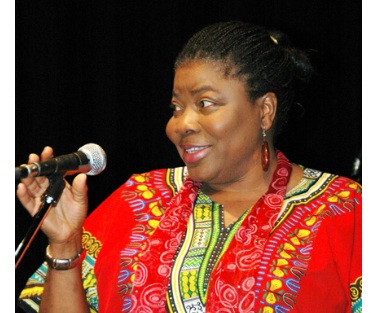
Funke Oba
Author: Funke Oba is the immediate past president of the African Canadian Association of Waterloo Region & Area. Funke teaches social work, is a diversity trainer/consultant and community based researcher with a focus on social justice, equity and social construction of complex phenomena.
Find more community responses about fear of crime:
Posted on: November 21st, 2013 by Smart on Crime
A woman’s purse is snatched as she walks downtown. A youth is swarmed and attacked by four other youth. A man pounds on his neighbour’s door, uttering threats when she refused to return his son’s football. The woman fears leaving her home. Fear of crime can skyrocket for such victims of crime. Trouble concentrating, hyper-vigilance, and a generalized feeling of being unsafe may ensue. Crime victims may install alarm systems, seek Peace Bonds, or relocate, but an increased fear of crime may persist. Friends and family, hearing about the crime, may also fear crime more.
Restorative justice can dramatically reduce crime victims’ post-traumatic stress symptoms and fear of crime. Restorative justice is a voluntary process that brings together the victim, perpetrator, and their supporters with trained facilitators to talk about how they have been affected by the crime, and who needs to do what to make things as right as possible. Community Justice Initiatives (CJI) in Kitchener has been a leader in this worldwide movement for nearly 40 years.
Carol, who was hit over the head with a broken bottle as her purse was snatched, had missed many days at work, overwhelmed by fear. In the seven months since the incident, she had been unable to face buying a new purse. When Carol and her daughter met with the perpetrator, Brianna, and Brianna’s grandmother in a facilitated process, Carol and her daughter described the far-reaching effects of the incident. Carol learned about Brianna’s traumatic history and ensuing drug habit that led to the robbery. She saw how upset Brianna’s grandmother was by Brianna’s behavior, and Brianna’s repentance and efforts to get on the right track. She learned Brianna was not the monster that she had imagined her to be, but a troubled young woman who had been the past victim of rape and abuse, trying to turn her life around. Carol’s fear was transformed. On the way home from the restorative justice process, she bought a new purse and returned the next day to work with confidence.
Vigit, who had been swarmed and hit by four other youths, no longer needed to look around anxiously as he left the house after he participated in a restorative justice process. In a follow-up interview, Vigit said, “It was great to get together with the individuals to discuss what happened. I was personally attacked and felt really unsafe at the time. This gave me peace of mind, and helped everyone move on.”
Similarly, Barbara, who was living in fear following threats Bill shouted while pounding on her door, experienced not only a renewed sense of safety, but deep compassion and support from her neighbours, who learned, as an outcome of the process, that her husband was dying of cancer. The football had come into her yard one too many times, and had damaged a birdbath made by her husband. Bill not only apologized for his threatening behavior and for bad-mouthing her character to all the neighbours. He volunteered to go around to all the neighbours and explain what had happened. The neighbours also came up with a new place for the youth to play football.
Research shows that burglary and robbery victims who go through a restorative justice process have a dramatic reduction in post-traumatic stress symptoms compared to those who don’t. Fear of crime drops not only for the direct victim, but for family, friends and neighbours, too, as they see the person responsible for the harm held accountable, apologize and take steps to repair the harm.
Just as a restorative justice process for cases before the courts can reduce fear of crime, use of restorative justice in schools can help to build a stronger sense of safety and community. Schools that use restorative justice to address crime and harm have lower suspension rates and higher perceptions of safety by staff and students. This typically leads to a more effective learning environment, less absenteeism of staff and students, and higher student achievement levels.
Restorative justice can also be used within the community to help people resolve escalating tensions between neighbours, on sports teams, or within housing developments. After meeting with trained mediators and addressing the underlying issues behind people’s positions, the fear of violence erupting is replaced with new understanding and a mutually acceptable way forward.
Contact Community Justice Initiatives for more information about restorative justice, or to explore using a restorative justice process to address a particular crime, harm or conflict. Be part of the movement to build healthier communities and reduce the fear of crime.
Community Justice Initiatives
49 Queen St. N—3rd floor
Kitchener, Ontario N2H 2G9
info@cjiwr.com | 519-744-6549
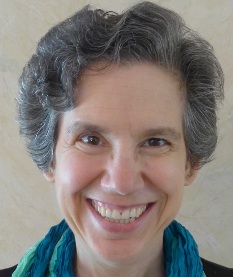 Author: Sue Klassen is completing her Masters in Conflict Transformation, with concentrations in Restorative Justice and Trauma Healing. As past president of Partners in Restorative Initiatives, a restorative justice agency in Rochester, NY, she has 12 years experience in working with restorative justice and trauma in courts, schools and the community, as a facilitator, trainer and advocate.
Author: Sue Klassen is completing her Masters in Conflict Transformation, with concentrations in Restorative Justice and Trauma Healing. As past president of Partners in Restorative Initiatives, a restorative justice agency in Rochester, NY, she has 12 years experience in working with restorative justice and trauma in courts, schools and the community, as a facilitator, trainer and advocate.
Find more responses about fear of crime:
Posted on: November 19th, 2013 by Waterloo Region Crime Prevention Council
Fear of crime may cause an increase in crime within a community. Although there is not a consensus in the literature around this point, it is clear that fear of crime is unwelcome and tends to negatively impact quality of life. Fear of crime is measured in this survey as the percentage of respondents indicating they feel very unsafe, or somewhat unsafe, walking alone in their area after dark.
The Statistics
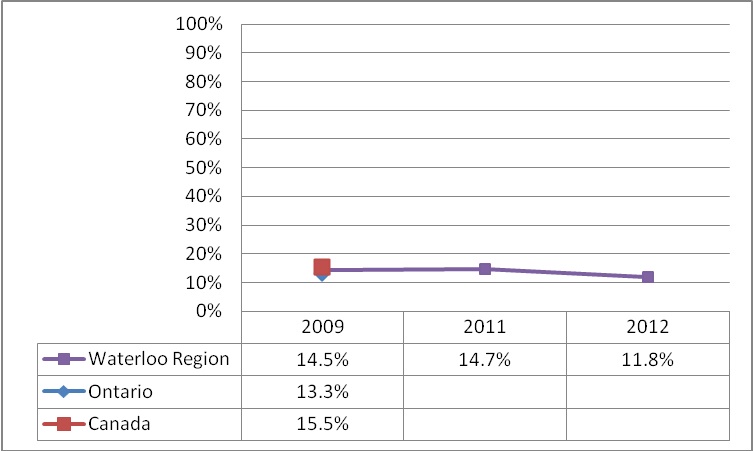 Data Sources: Statistics Canada General Social Survey Victimization Cycle (Released Every Five Years) University of Waterloo Survey Research Centre Local Area Survey (Released Annually)
Data Sources: Statistics Canada General Social Survey Victimization Cycle (Released Every Five Years) University of Waterloo Survey Research Centre Local Area Survey (Released Annually)
The Story Behind the Numbers
Levels of fear of crime in a community are expected to be relatively stable in the short term. Locally, levels of fear of crime are stable with changes within the margin of error. Comparing Waterloo Region to Ontario and Canada, the numbers are relatively similar with Waterloo Region appearing to have a slightly lower fear of crime than Canada.
Read the Community Responses:
Posted on: November 19th, 2013 by Smart on Crime
There has long been a perception that Kitchener’s downtown core is more unsafe than other downtowns and neighbourhoods in our Region. To dig deeper into the Snapshot in Time: Root Causes of Crime in Waterloo Region indicator on fear of crime, we tracked down the Mayor of Kitchener, Carl Zehr.
1) What is your response to the data presented on the fear of crime indicator? How does it make you feel when you reflect on this indicator?
The indicators in this report are generally not surprising to me since they reflect other statistics I have seen. While this region is often expected to do better than the rest of the province and country, it is clear that we are very similar to other CMA’s in Canada. There are a few areas where we rank a bit better in the indicators but it is clear that the general economic success of the region enjoys does not translate to every sector of our community. Given the recent information regarding crime in the downtown versus suburbs, we continually need to deal with the perception of crime versus the reality. The perception is the downtown is not safe – the reality is it’s growing, has changed dramatically and if crime is an issue, it’s more outside of the downtown. Perceptions need to change too. We therefore, collectively, have a lot more work to do.
2) Who is involved in addressing this issue in the community? What are you already doing about it?
Through the programs the city supports at the community centres and neighbourhood associations, many people have been busy providing value added and positive activities for the community as a whole, and, especially for youth. There are many independent not-for-profit organizations in the city and community that are also providing services and programs which allow people of all ages to “stay out of trouble”. Kitchener and other local governments provide funding for many of these organizations even though “it is never enough”.
Economic and education opportunities have a significant impact on crime rates. Indirectly the city’s economic development division helps the cause by working to create the climate for entrepreneurs and companies to succeed.
3) What else should be done and/or needs to be done about it?
As noted above, we have many organizations doing good work but I think the fact that there are so many may be holding the community from improving our ranking. Organizations and funding bodies, including governments, of these organizations need to give serious consideration to eliminating duplication of service and programs so that more resources can be directed towards to the programs and away from administration.
Many of these various agencies (connected to this issue and others) appear to be so competitive and spend a lot of time figuring out how to survive (writing grants, etc.) rather than working collaboratively or merging to improve programming/services. Streamlining services to have one access point helps people figure out where to get help. The Community Support Connections model, which merged 4 seniors’ agencies, is a good model and not many have followed it.
Thank you Mayor Zehr, for your insightful responses.
What do you think about fear of crime in Waterloo Region neighbourhoods?
Read more community responses about fear of crime:
Posted on: November 12th, 2013 by Waterloo Region Crime Prevention Council
Social capital refers to the human connections and capacities that contribute to the wealth and well being of a community. Social capital is developed in many ways such as participating in community groups, helping someone solve a problem or by saying hello to a neighbour. High levels of social capital have been linked to reduced violence in neighbourhoods. A community characterized by strong interpersonal connections helps to reduce crime by making it more likely that people in the community will watch over the neighbourhood. A simple and widely accepted measure of social capital asks the question, ‘Generally speaking, would you say that most people can be trusted or that you cannot be too careful in dealing with people?’
The Statistics
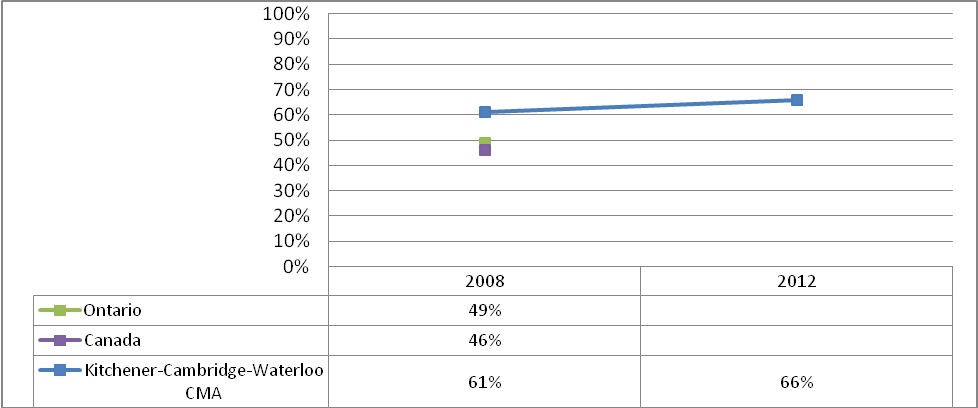
Data Sources: Statistics Canada, General Social Survey Time Use Cycle (Released Every Five Years); University of Waterloo Survey Research Centre, Local Area Survey (Released Annually)
The Story Behind the Numbers
Social trust is slightly higher in Ontario than it is in Canada and it is significantly higher in the Kitchener-Cambridge-Waterloo Census Metropolitan Area (CMA). Similar results were found on a second question in the 2008 General Social Survey, asking how much respondents trust people in their neighbourhood. The results bode well for Waterloo Region and present an important protective factor for the community. The increase in social capital between 2008 and 2012 is within the margin of error, indicating that social capital in the region is stable. Social capital does not form by itself. It tends to be the outcome of strategic and focused efforts on behalf of local institutions including the grass roots and local government to ensure an informed and engaged citizenry.
Read the Community Responses:
Life at 17 by Karen Scian, Waterloo City Councillor, Conestoga College instructor, Waterloo Public Library Trustee, Chair of the Board for Community Justice Initiatives
Posted on: November 12th, 2013 by Smart on Crime
I live a busy life. Like many of you, I wear a lot of hats in our community. I have a really hard time saying ‘no’ to people, causes, and commitments that intrigue me.
Which is how I found myself parked in gridlock on Toronto’s busy Lakeshore Drive one drizzly, grey, and miserable November evening … trying to make my way home to Waterloo from a series of meetings in the downtown. As usual, I was late. Also, as usual, I had been parenting my youngest son from afar via BBM … What’s up? Good day? How was football practice? Have you eaten? What homework do you have? Did you put the dog out? Always ending with: I love you, Peter. I love you too, Ma.
Peter’s responses were predictable. At 17, he was happy to have the house to himself. Sitting in my car, I could picture him in my mind: He came home from school, dumped his gear behind the sofa, gave the dog some love, headed straight to the fridge, and then upstairs to have a hot shower. He was likely comfortably lounging in our family room, making his way through the multitude of sports channels on cable. I knew he was safe, warm, fed, and had his beloved furry companion by his side.
As I inched my way towards a grey and dreary intersection on Lakeshore, I spotted the inevitable dance of captive motorists being courted by ‘squeegee kids’ with their proactive offers of clean windshields. Despite a 1999 provincial law that outlaws it and recent City of Toronto calls (2011) to come down hard on panhandlers, squeegeeing is the norm in Toronto: Cars stop at a light and nervous drivers avert their eyes or uncomfortably acknowledge the young people who approach their cars. I’ve been in this dance before, always leaving the dance floor with a sense of unease and emptiness.
I did the quick calculations. I was going to be the first car in line at the intersection. I had some spare change in the car, but I also needed a coffee. It was raining. I didn’t need my windows cleaned. I turned the radio up and did my best to pretend that I was an island.
I pulled up to the red light. Thoughts of Peter passed through my head: I hope he’s doing his homework.
I looked up and saw a young man standing on the boulevard. He looked nervous. He also looked wet and cold. His green eyes instantly reminded me of Peter. What if?
I couldn’t stop myself. I rolled down my window and called him over. His name was Joel. He was 17. I told him that I knew that. We chatted. I bypassed the spare change, reached into my designer handbag to open my designer wallet and gave him paper money. I gave him my business card. I asked him to call his mom. I got honked at. He very quietly thanked me. He packed up his backpack and crossed the street in front of me. He waved, walked, and then ran back to my window. He thanked me again and told me that he was going to get something to eat and that he would call his mom.
I turned off my radio. I wondered if Joel would follow through. I knew the chances were slim, but I had to believe that maybe, just maybe he would. I knew that many would ridicule me for thinking so. I had to hope.
I headed home to my son, who was still safe, warm, fed, and had his beloved furry companion by his side. I thought about my busy life and wondered if my work – the politics, the teaching, the community building, and the volunteer work – was helping or hindering my own social fabric. I love you Peter.
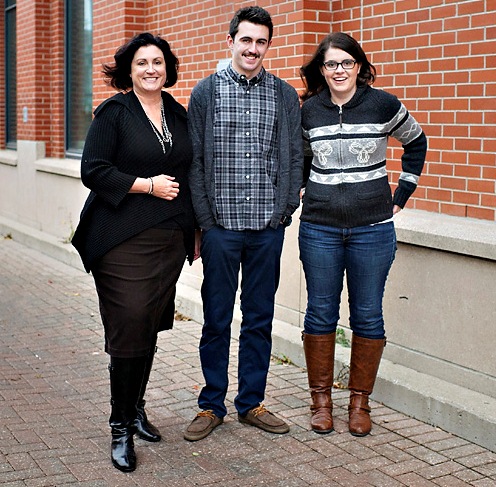
Karen Scian and her “Social Fabric”
Author: Karen Scian is a Waterloo City Councillor and Chair of the Finance and Strategic Planning Committee at the City of Waterloo. She holds a Bachelor of Science from the University of Waterloo, a Bachelor of Education from Western, and a Master of Arts in Leadership. Karen has spearheaded Waterloo’s commitment to open and transparent government by hosting innovative online events such as an All-Access Budget Townhall, Twitter Townhalls, and working with the community to revamp the City of Waterloo’s Citizen Committees. Karen is an instructor at Conestoga College’s School of Business and Hospitality, teaching Civic Engagement, Urban Studies, Ethics, and Sustainability Management to tomorrow’s leaders. She is also a trustee of the Waterloo Public Library and the Chair of the Board of Directors for Community Justice Initiatives (CJI), a local restorative justice organization.
Posted on: October 30th, 2013 by Waterloo Region Crime Prevention Council
Thanks to the Waterloo Region Crime Prevention Council for their 2012 report A Snapshot in Time: The Root Causes of Crime in Waterloo Region. The report has been a conversation starter for important dialogue in our community. It shines a spotlight on the root causes of crime locally, and uses calls to our Centre’s 24 Hour Crisis and Support Line as a data point related to local sexualized crimes.
We know that securing data about the prevalence of sexual violence can be challenging; sexual assault is the most under-reported violent crime in Canada. In 2012 the Waterloo Regional Police Service received 558 sexual assault reports. While that number itself is alarming, we only begin to understand the magnitude of sexualized crimes in our community when we consider that less than 10% of sexual assaults are reported to police nationally. Therefore, pulling data from a number of sources enhances our understanding of this complex issue.
Over the years, our crisis call numbers have fluctuated. In the last decade, there’s been a trend towards a moderate decline in the number of calls received, but the overall demand for our services has increased significantly. The explanation for this is simple; historically we provided more basic information related to services and supports on our crisis line. With much of that information now readily available online, the calls we most often receive today are supportive in nature or focused on crisis intervention.
With new ways of communicating emerging, our Centre has begun to explore the option of incorporating live online support into our crisis and support services.
Who else is involved in addressing this issue?
Awareness of the prevalence and impact of sexual violence has begun to increase regionally, thanks to the commitment of community partners to work in a spirit of collaboration.
In 2007, our community began to mobilize on this issue. A number of service providers formed a network which evolved into the Sexual Assault Response Team of Waterloo Region (SART). SART is now a community coordinating committee made up of 18 partner agencies from the criminal justice sector, the health sector, and the social services sector.
In 2012, SART launched a community protocol for responding to sexual assault in our region. The first such protocol of its kind in Waterloo Region, its purpose is to give service providers a broader foundation for the work they do. The protocol establishes a common understanding and framework for the provision of services to survivors of sexual violence, enabling greater coordination and collaboration between community partners.
What should be done?
Sexual violence impacts people of every age and cultural background, and has devastating impacts on individuals, families and communities. Every survivor, regardless of gender, deserves access to specialized support services in our community to promote healing.
As a region and more broadly, we need to balance our investment in support services for survivors of sexual violence and with public education campaigns aimed at prevention. We have consistently seen that early-intervention and prevention are necessary and cost effective.
It is important to understand, however, that sexual violence is primarily perpetrated by men, against women, children, and trans people.
According to a 2006 Statistics Canada report, more than one in three women will experience some form of sexual assault in her adult lifetime (p24). Over 93% of reported adult sexual assault victims are female, while 97% of those accused are male (p37).
As such, we need to consider social constructions of gender when looking at the prevention of sexualized crimes. Sexual violence is about power and control, not sexual desire. It is about aggressively dominating someone else.
This knowledge was the impetus behind the creation our Male Allies Against Sexual Violence (MAASV) program in 2008. MAASV is a unique public education program focused on working with men in positions to influence male youth (such as coaches, faith leaders, teachers, and fathers). The program explores how popular conceptions of masculinity can limit men’s freedoms and harm others. MAASV encourages young men to treat women with fairness, equality and respect and to stand up and speak out on gendered violence. (More information on MAASV can be found here: www.MaleAllies.org)
Sexual violence is pervasive, but it’s not inevitable. Through public education, social change is possible. A better future exists for our daughters and our sons.
 Author: Sara Casselman is the Public Relations & Operations Manager at the Sexual Assault Support Centre of Waterloo Region. In the anti-violence against women sector for more than a decade, Sara has been recognized provincially as a Leading Women, Building Communities Award Recipient (2011) and was featured in The Record’s 40 under 40 (2012).
Author: Sara Casselman is the Public Relations & Operations Manager at the Sexual Assault Support Centre of Waterloo Region. In the anti-violence against women sector for more than a decade, Sara has been recognized provincially as a Leading Women, Building Communities Award Recipient (2011) and was featured in The Record’s 40 under 40 (2012).

 Date Sources: Statistics Canada, Uniform Crime Reporting Survey: CANSIM Table 2520051
Date Sources: Statistics Canada, Uniform Crime Reporting Survey: CANSIM Table 2520051

 Data Sources: Statistics Canada, Census (Released Every Five Years); Statistics Canada, CANSIM Table 111-0015 (Released Annually)
Data Sources: Statistics Canada, Census (Released Every Five Years); Statistics Canada, CANSIM Table 111-0015 (Released Annually) Author: Julie Phillips, a native of Cambridge, has an interest for world missions as well as local outreach. As the former Executive Director with Big Brothers Big Sisters of Cambridge she played a key role in the successful merger of the Cambridge and Kitchener-Waterloo chapters. With 12 years of experience in the non-profit sector and as Chief Operating Officer of
Author: Julie Phillips, a native of Cambridge, has an interest for world missions as well as local outreach. As the former Executive Director with Big Brothers Big Sisters of Cambridge she played a key role in the successful merger of the Cambridge and Kitchener-Waterloo chapters. With 12 years of experience in the non-profit sector and as Chief Operating Officer of
 Author: Sue Klassen is completing her Masters in Conflict Transformation, with concentrations in Restorative Justice and Trauma Healing. As past president of Partners in Restorative Initiatives, a restorative justice agency in Rochester, NY, she has 12 years experience in working with restorative justice and trauma in courts, schools and the community, as a facilitator, trainer and advocate.
Author: Sue Klassen is completing her Masters in Conflict Transformation, with concentrations in Restorative Justice and Trauma Healing. As past president of Partners in Restorative Initiatives, a restorative justice agency in Rochester, NY, she has 12 years experience in working with restorative justice and trauma in courts, schools and the community, as a facilitator, trainer and advocate. Data Sources: Statistics Canada General Social Survey Victimization Cycle (Released Every Five Years) University of Waterloo Survey Research Centre Local Area Survey (Released Annually)
Data Sources: Statistics Canada General Social Survey Victimization Cycle (Released Every Five Years) University of Waterloo Survey Research Centre Local Area Survey (Released Annually)

 Author: Sara Casselman is the Public Relations & Operations Manager at the
Author: Sara Casselman is the Public Relations & Operations Manager at the